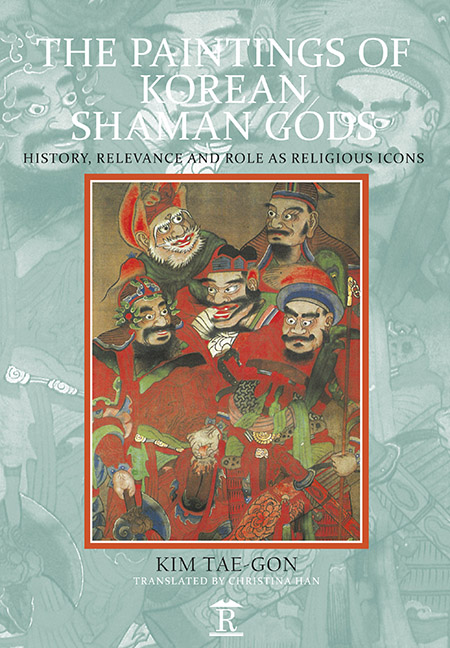Book contents
- Frontmatter
- Contents
- Translator’s Preface
- List of Figures
- List of Plates
- Introduction Visions, Images, Performance: Understanding Korean Shaman Art
- Chapter 1 Paintings Of Korean Shaman Gods
- Chapter 2 The Shaman God Painting As An Icon And Its Artistic Qualities
- Images Of Korean Shaman Gods
- Glossary of Terms
Chapter 1 - Paintings Of Korean Shaman Gods
Published online by Cambridge University Press: 30 April 2022
- Frontmatter
- Contents
- Translator’s Preface
- List of Figures
- List of Plates
- Introduction Visions, Images, Performance: Understanding Korean Shaman Art
- Chapter 1 Paintings Of Korean Shaman Gods
- Chapter 2 The Shaman God Painting As An Icon And Its Artistic Qualities
- Images Of Korean Shaman Gods
- Glossary of Terms
Summary
PAINTINGS OF SHAMAN GODS – A NOTE ON TERMINOLOGY
Paintings of shaman gods (musindo) are realistic portrayals of deities venerated by shamans on the Korean peninsula. They are regarded as portraits of gods, but their sacred attributes distinguish them from portraits in general. Their connection to shamanism sets them apart from other religious paintings. From time to time, the paintings of shaman gods are also called “shaman paintings (musindo)” or “shamanism paintings (musindo).” Since these divergent expressions can lead to confusion, I would like to start with a terminological inquiry.
The expression “shaman paintings” can be used to describe paintings about shamans, as well as paintings used by shamans in ritual and worship. In addition to portraits of gods, the inclusive term “shaman paintings” can also denote shamans’ painted fans which are used by shamans during ritual performance, as well as simple drawings produced during the exorcism ritual. An even broader concept, “shamanism paintings,” refers to genre paintings depicting scenes from shaman rituals and other activities, as well as to paintings that fall under the category of “shaman paintings.” The genre paintings of Sin Yun-bok (b. 1758) depicting shaman rituals are excellent examples of shamanism paintings.
Compared to the first two expressions, “paintings of shaman gods” is a specific term that describes the portraits of the gods worshipped by shamans. Since the expression has been widely used in the academic setting, I have adopted it in this book in order to avoid terminological confusion.
THE HISTORY AND FORMATION OF SHAMAN GOD PAINTINGS
The History of Shaman God Paintings in Korea
The origins and history of shaman god paintings are difficult to determine. The earliest written account of the paintings of shaman gods comes from the mid-Goryeo publication, Dongguk Yi Sangguk jip (Collected Works of Minister Yi of Korea). In the preface to the chapter entitled “Old shaman,” author Yi Gyu-bo (1168–1241) wrote: “the shaman plays the janggo (an hourglass-shaped drum) and dances before the altar. On the walls are hung colorful paintings of shaman gods.” Although without a visual record we do not know what these paintings looked like, the “colorful paintings of shaman gods” mentioned by Yi are generally believed to be the precursors to the paintings we see later in the Joseon dynasty.
- Type
- Chapter
- Information
- The Paintings of Korean Shaman GodsHistory, Relevance and Role as Religious Icons, pp. 13 - 44Publisher: Amsterdam University PressPrint publication year: 2018
- 1
- Cited by



